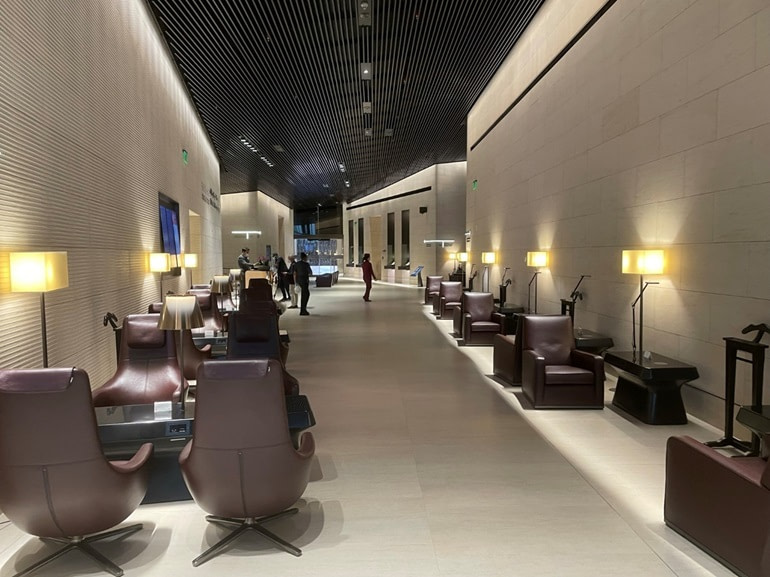As drag goddess Coco Peru introduces her spouse: “Meet my husband, Rafael. He’s from Spain.”
There’s a good reason for that. This country is chock full of men – and women – so beautiful you want to slap them. And this eye candy is certainly a bonus when visiting this popular European country. (It’s where I began my photographic essay on Hot Cops.) But the reason Spain tops so many must-visit lists is because of its startling array of fairly breathtaking sights.
Now, I’d long assumed that the bulk of those were in Madrid and Barcelona, and I’d never given any real thought to the rest of Spain. (Barcelona, in particular, with its over-the-top Gaudi buildings, is one of my top five European cities.) But it turns out that Andalucia – pronounced “An-da-loo-see-uh” – a region in the southern part of the country is jam-packed with UNESCO and other can’t-miss sights.
Brand g offers a luxury land tour of Andalucia that presents the best of these over-the-top monuments, palaces and the like, and our 2023 tour was a smash hit. Limited space is still available (at this writing) for our 2024 version. But whether you go with us or travel here on your own, there are certain sights you absolutely cannot miss.
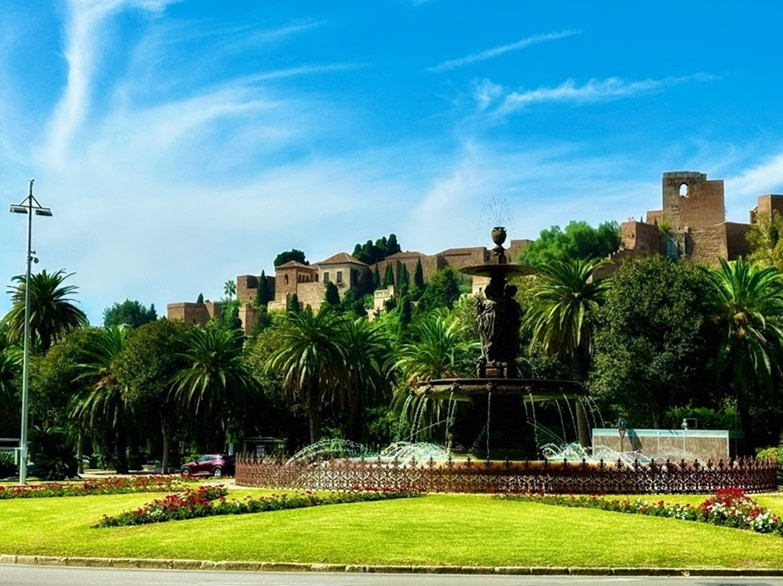
(The Alcazaba – Malaga)
HOW TO TRAVEL AROUND ANDALUCIA
The best option – outside of taking the Brand g version of this trip and letting us handle everything – is to base yourself somewhere that’s reasonably central and do day trips. Seville and Malaga are the most popular options. Both of these are fairly equidistant from the cities you’ll want to see, here; and from either of these you can drive (or better yet, train) to the other cities.
If you’re taking the train – which we recommend, since finding parking can be tougher than snagging one of those hot Spaniards – there are generally a handful of trains each day that will whisk you roundtrip to the other destinations in an hour or two, typically for only $20-50 roundtrip. And the trains are clean and comfortable (and air-conditioned, praise Jesus).
Note: These are not exactly Swiss or German trains. While they typically run on time, friends had a couple of instances where trains were cancelled or delayed; so be sure not to schedule anything too close to the time you arrive or return. They had a dinner scheduled with friends upon their return, and when the train was two hours late, they ended up at the restaurant sweaty, stressed and looking like they’d been hit by that train.
A NOTE ABOUT TOURING ATTRACTIONS IN SPAIN
A number of tourist sites require you to have a photo ID. And a xerox copy of your passport won’t do. It has to be your true driver’s license or passport, so be sure to have one of these with you when touring. Some of the entrance personnel are stricter than others, but we saw them turn people away, so don’t take the chance.
SEVILLE
Seville is simply breathtaking. Chock full of Spanish and Moorish architecture, Spain’s capital is home to three UNESCO World Heritage sites, two of which are especially memorable.
The Alcazar
This royal palace complex, begun in the 10th century, is a crazy mashup of Islamic, Gothic, Renaissance, Baroque and Romantic elements, a reflection of the centuries of construction and demolition as the country hung out its “under new management” sign. The oldest European palace still in use, it’s conveniently located in easy walking distance to the Seville Cathedral. Plan to spend a couple hours here.
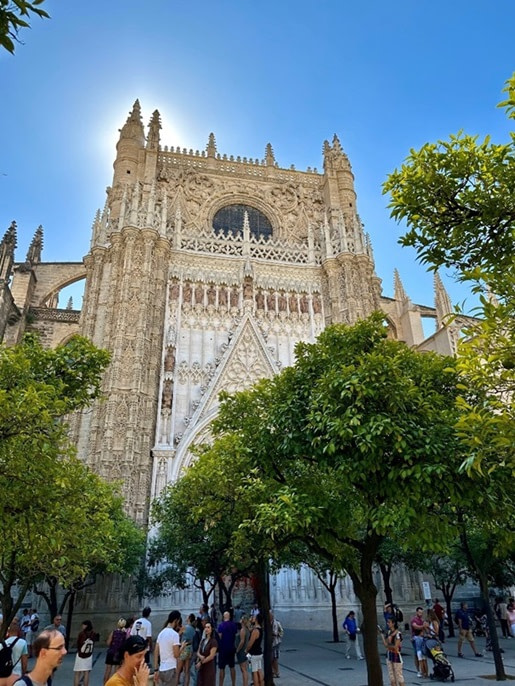
(Seville Cathedral)
Seville Cathedral
Until I set foot in this massive church, I had no idea that it was bigger than Notre Dame. It is, in fact, the world’s largest gothic cathedral, and indeed the largest gothic building in all of Europe. And it’s eye-popping in its majesty. Built over 80 years beginning in the early 15th century, it is a stunning testament to the glory of God and (probably) slave labor. Take note of the five naves, the tomb of Christopher Columbus, and the incredible detail work that goes all the way up to the rafters. Plan to spend about 90 minutes, here.
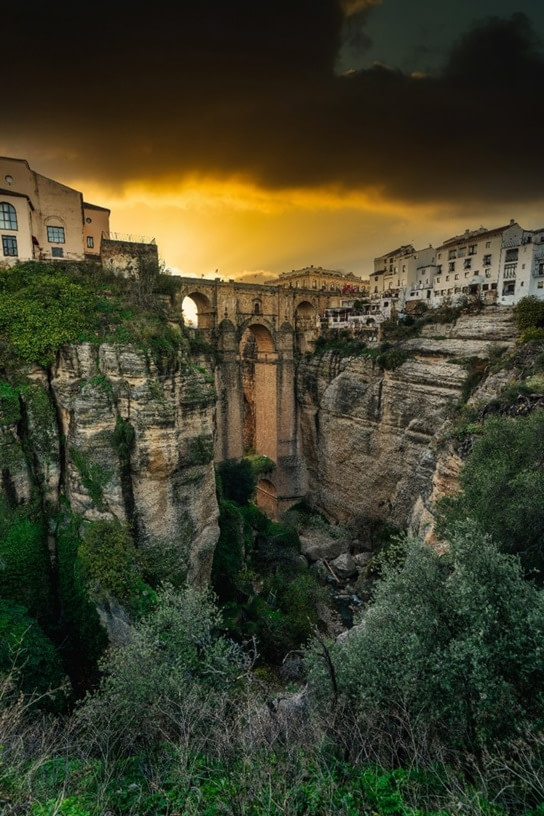
(Ronda)
RONDA
Ronda doesn’t have the wildly impressive palaces or churches that Seville and Granada do, but it does have one jaw-dropping sight: this mountaintop city is set dramatically above a very deep gorge that separates the Old Town from the (15th century) new town. This one photo op alone is worth the trip, particularly if you’re staying somewhere like Malaga, where it’s just a cheap, one-hour train ride away.
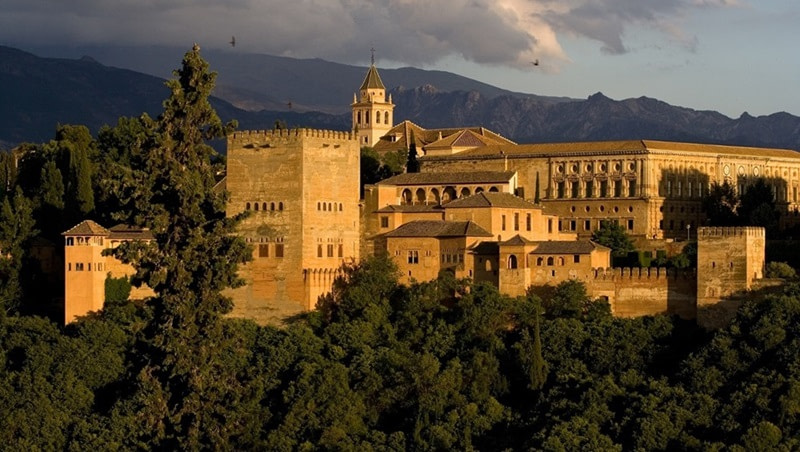
GRANADA
Granada rivals – and perhaps even surpasses – Seville in the over-the-top department, with its massive Alhambra, which includes the Nasrid Palaces and Generalife Gardens.
This 35-acre palace and fortress complex is one of the most famous examples of Islamic architecture in the world. Begun in the 13th century, it houses two palaces, the alcazaba (military installation) and the gorgeous Generalife gardens. If you come in the warmer months, the gardens are quite the Instagram moment.
If you’re not taking the Brand g Andalucia trip (which includes not only a guided tour of the Alhambra but an exclusive drinks reception and lunch inside the palace), be sure to take a guided tour, here. There is so much to see that it’s impossible to properly take it in without a guide.
Plan to spend 3+ hours, here, and wear comfortable shoes. It’s a lot of walking (but completely worth it).
Tip: enjoy a meal at one of the two onsite restaurants. They have lovely park views!
BUT WAIT, THERE’S MORE
There are other cities also worth a visit in the Andalucia region – Cordoba, Gibraltar – but unless you have at least a week to devote to touring here, stick to the recommendations above. But as you can see, Andalucia is essentially a monument Disneyland with a lot of e-ticket attractions. If you’re heading to Spain (or Portugal, since many people combine the two neighboring countries into one trip), it’s an area you absolutely should not miss.


